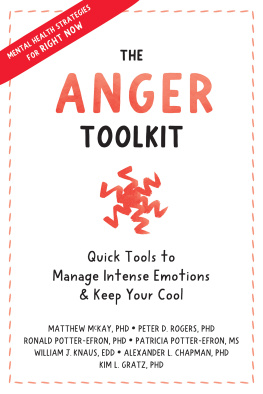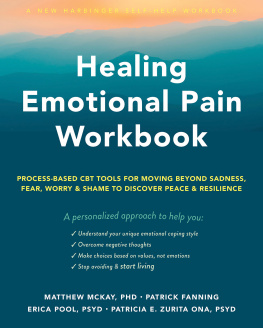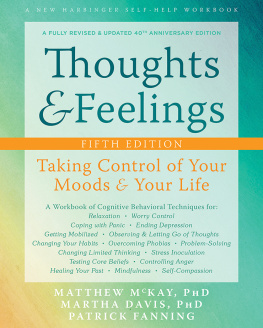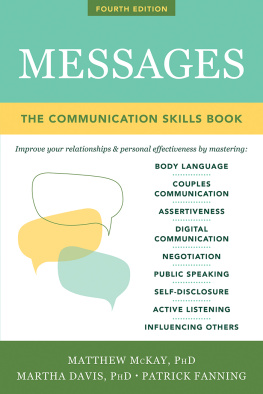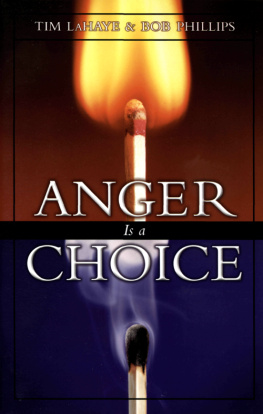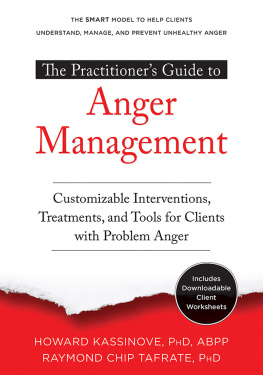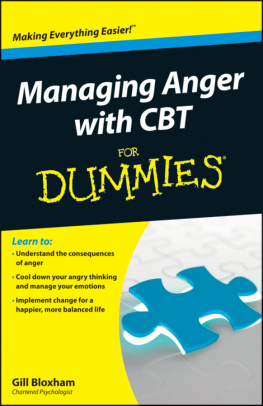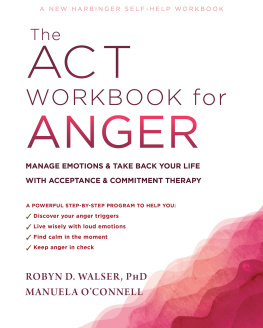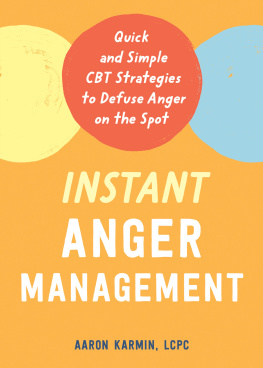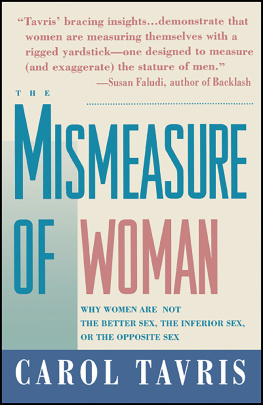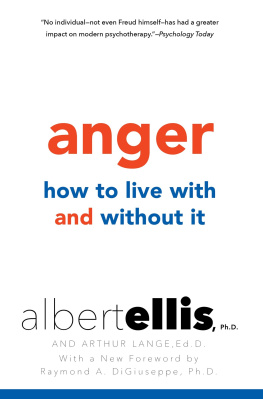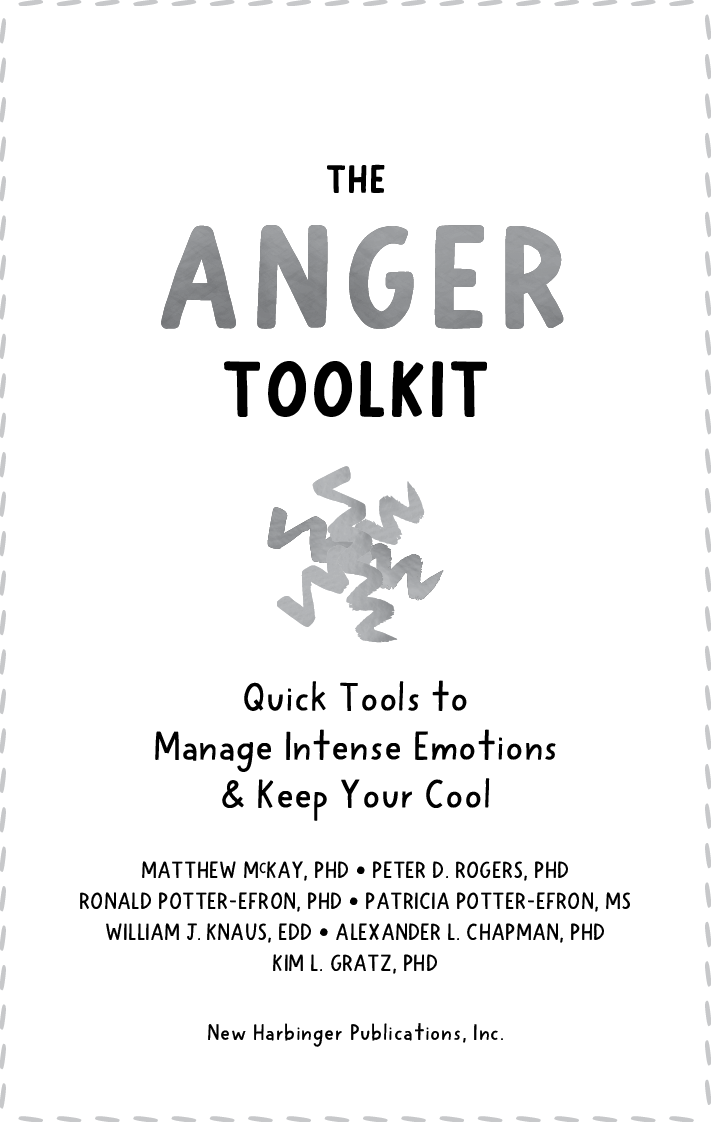Publishers Note
This publication is designed to provide accurate and authoritative information in regard to the subject matter covered. It is sold with the understanding that the publisher is not engaged in rendering psychological, financial, legal, or other professional services. If expert assistance or counseling is needed, the services of a competent professional should be sought.
Distributed in Canada by Raincoast Books
NEW HARBINGER PUBLICATIONS is a registered trademark of New Harbinger Publications, Inc.
Copyright 2023 by Matthew McKay, Peter D. Rogers, Ronald Potter-Efron, Patricia Potter-Efron, William J. Knaus, Alexander L. Chapman, Kim L. Gratz
New Harbinger Publications, Inc.
5674 Shattuck Avenue
Oakland, CA 94609
www.newharbinger.com
Cover design by Amy Shoup; Acquired by Elizabeth Hollis Hansen; Edited by Brady Kahn
All Rights Reserved
Library of Congress Cataloging-in-Publication Data
Names: McKay, Matthew, author. | Rogers, Peter D. (Peter Denny), 1941- author. | Potter-Efron, Ronald T., author.
Title: The anger toolkit : quick tools to manage intense emotions and keep your cool / Matthew McKay, PhD, Peter D. Rogers, PhD, Ronald Potter-Efron, PhD, Patricia Potter-Efron, PhD, William J. Knaus, PhD, Alexander L. Chapman, PhD, Kim L. Gratz, PhD.
Description: Oakland, CA : New Harbinger Publications, 2023. | Includes bibliographical references.
Identifiers: LCCN 2022036464 | ISBN 9781648481338 (trade paperback)
Subjects: LCSH: Anger. | Control (Psychology) | Self-help techniques. | BISAC: SELF-HELP / Self-Management / Anger Management (see also FAMILY & RELATIONSHIPS / Anger) | FAMILY & RELATIONSHIPS / Anger (see also SELF-HELP / Self-Management / Anger Management)
Classification: LCC BF575.A5 M367 2023 | DDC 152.4/7--dc23/eng/20220825
LC record available at https://lccn.loc.gov/2022036464
Contents
Introduction
These are extreme and uncertain times. From natural disasters to downsizing and automation to global pandemics that previously seemed unimaginablenot to mention political division about all of these thingswe have more than enough to feel angry about.
By picking up this book, you are likely seeking relief from the burden of anger and the pain it causes you and others. Sometimes anger can be a helpful emotion, such as when it pushes you to stand up for yourself or others you care about or to advocate for a cause that you believe in. Other times, anger becomes intense and overwhelming and leads to urges to act in destructive or harmful ways. Often, anger is a response to pain, a way of coping when something feels very wrong or out of your control.
This book can help. The mental health tools contained in this anger management toolkit can give you a welcome respite from angry outbursts and resentments, so you can focus on finding calm in the here and now.
This short book compiles the easiest and most effective anger-reducing exercises, techniques, and practices from top mental health experts, all of whom have put these skills into practice with clients. In addition, the techniques come from evidence-based treatments. Evidence-based means not only that the tools in this book have worked for decades with hundreds of clientsthey havebut also that they have been tested and approved in research labs all over the world.
Perhaps you have heard about cognitive behavioral therapy, dialectical behavior therapy, or neuroscience. If you have, then you might have a sense of how this book will help you. If you havent, dont worry. Knowing about these therapies is not important when it comes to getting the most out of this book: improving your mood, getting a better understanding of your thoughts, and making sure that you are living in accordance with what really matters to you. If you are already interested in these therapies or if this book inspires your curiosity, you can explore these topics further in any number of books from New Harbinger Publications. We have suggested some supplementary reading at the back of the book.
You will first learn some techniques to reduce anger and hurtful actions toward yourself and others before you start on the more difficult work of managing the pain behind your anger. If youre able, work through this book from beginning to end, because its easier to work on your anger once youve established a baseline of calm, or nonreactivity.
All of the techniques in this book can be used at a moments noticeas needed and on demand. To get you what you need when you need it, you can begin using these techniques right away. For example, if a mindfulness exercise works well for you, go ahead and make it a habit before moving on to a new technique. The techniques are flexible enough to work with any kind of anger thought or feeling, so its fine to jump in and out. Perhaps leaving the book on the coffee tableor somewhere else where it is readily availablecan help you access relief when you need it. Keeping a journal will also help, especially with exercises that ask you to write things down.
As you move through the book, try to bring whatever amount of playfulness you can to these exercises and techniques. This can be tough when youre struggling. But do your best to keep an open mind. That said, if something doesnt feel like its working for you, drop it and move on to something else. In these pages, you are the priority.
You also dont have to define yourself as a person with a bad anger problem to use this book. After all, everyone gets angry from time to time. Most of us get stuck at least once in a while, not knowing what to say or do with our anger. This book is designed to give readers with at least some anger problems quick and effective ways to manage their anger.
These truly are distressing times, but finding a moment to take care of your mental health doesnt have to be. With thatits time to take a deep breath and turn the page.
Part 1:
Get Anger Relief Right Away
Sometimes you need quick guidelines on how to defuse anger right away. Even though anger can be a helpful emotion, managing angerespecially when that anger is intense and overwhelmingcan seem like an insurmountable goal. When people experience anger, they often have urges to act in ways that wont be effective and could actually make a situation worse. Do you notice that many of the urges associated with anger involve behaviors that are destructive?
One of the best things you can do when youre experiencing intense anger is to avoid acting on your urges. Not acting on your anger when youre most angry can protect you from some of the downsides of anger and keep you out of trouble. The emergency anger control skills in this section of the book are designed to help you avoid acting on intense anger and making things worse.
Stop Blaming Yourself
What to Know
From the very start, its important to get one thing straight: you arent to blame because you struggle with anger. You are not a bad person because youve forgottenperhaps repeatedlyall your resolutions to be cool and calm. Rather, you are a person in pain.
Often the roots of anger can be traced back to earlier times when you were hurt, abused, or neglected in your family of origin. The pain was something you carried, year after year. It may have left scars so that now its hard to feel safe or loved or truly worthy. Sometimes it doesnt take much of a provocation to trigger those feelings of being unloved, unworthy, or unsafeand the anger rises up right alongside that old pain.

